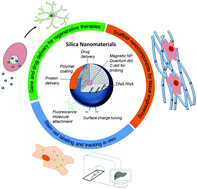当前位置:
X-MOL 学术
›
Mater. Horiz.
›
论文详情
Our official English website, www.x-mol.net, welcomes your
feedback! (Note: you will need to create a separate account there.)
Silica-based multifunctional nanodelivery systems toward regenerative medicine
Materials Horizons ( IF 12.2 ) Pub Date : 2017-06-12 00:00:00 , DOI: 10.1039/c7mh00017k Roman A. Perez 1, 2, 3, 4, 5 , Rajendra K. Singh 1, 2, 3, 4, 5 , Tae-Hyun Kim 1, 2, 3, 4, 5 , Hae-Won Kim 1, 2, 3, 4, 5
Materials Horizons ( IF 12.2 ) Pub Date : 2017-06-12 00:00:00 , DOI: 10.1039/c7mh00017k Roman A. Perez 1, 2, 3, 4, 5 , Rajendra K. Singh 1, 2, 3, 4, 5 , Tae-Hyun Kim 1, 2, 3, 4, 5 , Hae-Won Kim 1, 2, 3, 4, 5
Affiliation

|
Silica-based nanomaterials (SiNMs) with different forms, including nanoparticles, nanorods and nanofibers either with a dense, porous or hollow structure, have been demonstrated as fascinating platforms for the delivery of therapeutic molecules in the inorganic nanocarrier regime. This is primarily due to their unique physicochemical properties, which are effective and tunable for the uptake of different cargo molecules, as well as to their biological responses favorable for cells and tissues. Over the last decade, a substantial number of studies have exploited SiNMs with different shapes, sizes, mesopore structures and surface charges for use in cancer therapy, imaging and bioseparation. In particular, their surface can be functionalized with candidate molecules from dyes to drugs for theranostic purposes. Moreover, providing the carriers with intelligent modes, such as stimuli-responsiveness, and with multifunctionality through combining them with imaging particles (magnetic nanoparticles, quantum dots and carbon dots) improves their therapeutic and diagnostic potential. While many pioneering works in the SiNM systems have focused on cancer therapy, there is growing demand for using SiNMs in the area of regenerative medicine, for stem cell therapy and tracking, and for the repair of dysfunctional tissues. Here we review the most recent advances in SiMNs that are available for regenerative therapies. For this, we first give an overview of the general nanostructure forms and characteristics of the SiNMs from a physicochemical and biological point of view, and then deal with the intracellular uptake mechanism and toxicity issues. Finally, advanced designs of SiNMs to provide multifunctional and intelligent actions of loading and delivery of drugs and molecules are detailed, and then perspectives for their potential uses in regenerative medicine are provided.
中文翻译:

基于二氧化硅的多功能纳米递送系统,用于再生医学
具有不同形式的基于二氧化硅的纳米材料(SiNMs),包括具有致密,多孔或中空结构的纳米颗粒,纳米棒和纳米纤维,已被证明是在无机纳米载体体系中递送治疗性分子的引人入胜的平台。这主要归因于它们独特的理化特性,这些特性对于摄取不同的货物分子是有效且可调节的,以及它们对细胞和组织有利的生物学反应。在过去的十年中,大量研究已开发出具有不同形状,大小,中孔结构和表面电荷的SiNM,用于癌症治疗,成像和生物分离。特别是,出于治疗的目的,它们的表面可以用从染料到药物的候选分子进行功能化。而且,通过将载体与成像颗粒(磁性纳米颗粒,量子点和碳点)结合使用,为载体提供诸如刺激反应性等智能模式并具有多功能性,可提高其治疗和诊断潜能。尽管SiNM系统中的许多开创性工作都集中在癌症治疗上,但对于在再生医学领域中使用SiNM,用于干细胞治疗和追踪以及修复功能失调的组织的需求日益增长。在这里,我们回顾了可用于再生疗法的SiMNs的最新进展。为此,我们首先从理化和生物学的角度概述了SiNMs的一般纳米结构形式和特征,然后处理细胞内摄取机制和毒性问题。最后,
更新日期:2017-08-29
中文翻译:

基于二氧化硅的多功能纳米递送系统,用于再生医学
具有不同形式的基于二氧化硅的纳米材料(SiNMs),包括具有致密,多孔或中空结构的纳米颗粒,纳米棒和纳米纤维,已被证明是在无机纳米载体体系中递送治疗性分子的引人入胜的平台。这主要归因于它们独特的理化特性,这些特性对于摄取不同的货物分子是有效且可调节的,以及它们对细胞和组织有利的生物学反应。在过去的十年中,大量研究已开发出具有不同形状,大小,中孔结构和表面电荷的SiNM,用于癌症治疗,成像和生物分离。特别是,出于治疗的目的,它们的表面可以用从染料到药物的候选分子进行功能化。而且,通过将载体与成像颗粒(磁性纳米颗粒,量子点和碳点)结合使用,为载体提供诸如刺激反应性等智能模式并具有多功能性,可提高其治疗和诊断潜能。尽管SiNM系统中的许多开创性工作都集中在癌症治疗上,但对于在再生医学领域中使用SiNM,用于干细胞治疗和追踪以及修复功能失调的组织的需求日益增长。在这里,我们回顾了可用于再生疗法的SiMNs的最新进展。为此,我们首先从理化和生物学的角度概述了SiNMs的一般纳米结构形式和特征,然后处理细胞内摄取机制和毒性问题。最后,











































 京公网安备 11010802027423号
京公网安备 11010802027423号